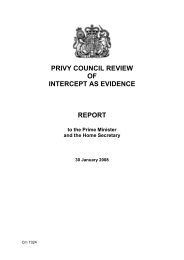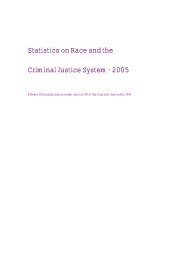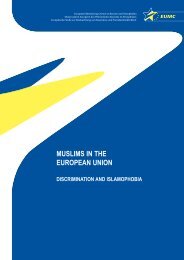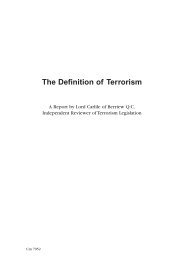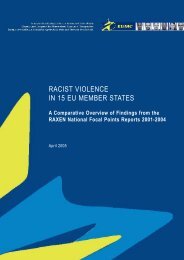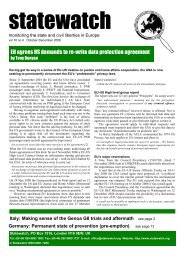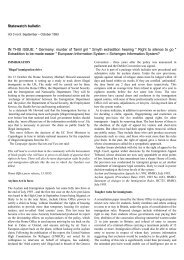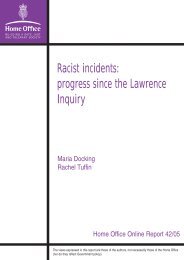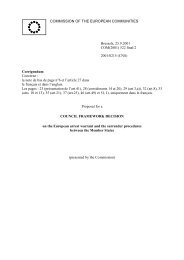Homophobia and Discrimination on
Homophobia and Discrimination on
Homophobia and Discrimination on
Create successful ePaper yourself
Turn your PDF publications into a flip-book with our unique Google optimized e-Paper software.
C<strong>on</strong>clusi<strong>on</strong>s<br />
LGBT pers<strong>on</strong>s are subject to homophobia <str<strong>on</strong>g>and</str<strong>on</strong>g> discriminati<strong>on</strong> in the labour market in a<br />
number of ways: direct discriminati<strong>on</strong>, harassment, bullying, ridicule <str<strong>on</strong>g>and</str<strong>on</strong>g> being socially<br />
'frozen out'. Due to the invisibility of LGBT pers<strong>on</strong>s <str<strong>on</strong>g>and</str<strong>on</strong>g> a relatively low level of recorded<br />
complaints to Nati<strong>on</strong>al Equality Bodies, the actual extent of homophobia, transphobia<br />
<str<strong>on</strong>g>and</str<strong>on</strong>g> discriminati<strong>on</strong> is not possible to determine. A general lack of awareness of rights,<br />
together with the reluctance of LGBT pers<strong>on</strong>s to publicly display their sexual orientati<strong>on</strong><br />
or gender identity through a tribunal or court case partly explain this phenomen<strong>on</strong>.<br />
Many workplaces are currently not c<strong>on</strong>sidered 'safe havens' for LGBT staff. Although<br />
data varies according to nati<strong>on</strong>al c<strong>on</strong>text, studies <str<strong>on</strong>g>and</str<strong>on</strong>g> interviews with Nati<strong>on</strong>al Equality<br />
Bodies <str<strong>on</strong>g>and</str<strong>on</strong>g> LGBT NGOs dem<strong>on</strong>strate that the majority of LGBT pers<strong>on</strong>s are generally<br />
reluctant, or somewhat reluctant, to being out <str<strong>on</strong>g>and</str<strong>on</strong>g> open in the workplace.<br />
Past experiences or fear of homophobia <str<strong>on</strong>g>and</str<strong>on</strong>g> discriminati<strong>on</strong>, the risk of dismissal <str<strong>on</strong>g>and</str<strong>on</strong>g> the<br />
workplace envir<strong>on</strong>ment all play a role in determining LGBT pers<strong>on</strong>s’ decisi<strong>on</strong>s about<br />
openness in the workplace. Nevertheless, closeted sexual orientati<strong>on</strong>s affect the health<br />
<str<strong>on</strong>g>and</str<strong>on</strong>g> well-being of LGBT staff <str<strong>on</strong>g>and</str<strong>on</strong>g> may result in less satisfactory work results.<br />
The role of management, as well as the presence or lack of diversity <str<strong>on</strong>g>and</str<strong>on</strong>g> equal<br />
treatment policies, has implicati<strong>on</strong>s for LGBT pers<strong>on</strong>s' percepti<strong>on</strong> of a safe <str<strong>on</strong>g>and</str<strong>on</strong>g> inclusive<br />
work envir<strong>on</strong>ment. Here, the presence of employment equality legislati<strong>on</strong>, <str<strong>on</strong>g>and</str<strong>on</strong>g> its<br />
inclusi<strong>on</strong> of LGBT pers<strong>on</strong>s, influences the incentives to bring discriminati<strong>on</strong> cases<br />
forward.<br />
Part II - The Social Situati<strong>on</strong><br />
71



